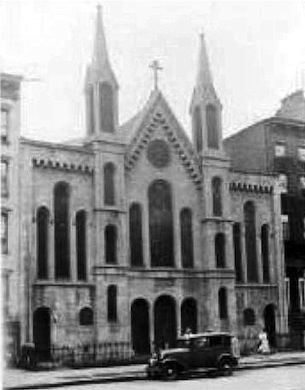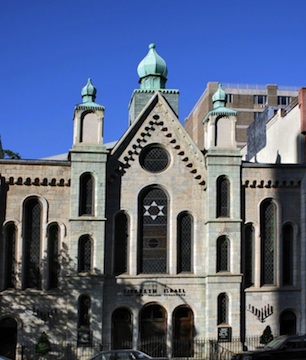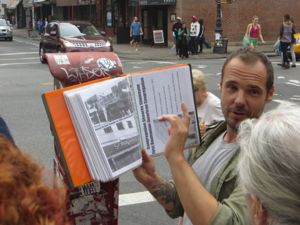
Landmark Tifereth Israel Synagogue Building!
In 1966 – almost 50 years ago – the NYC Landmarks Preservation Commission calendared the Tifereth Israel Town and Village Synagogue building for Individual Landmark designation, as one of its very early proposed designations (the LPC began its first public hearings for landmarking buildings in 1965).
Last October, amidst reports that the congregation may seek to substantially alter the building or

The building’s history reflects demographic changes in the Lower East Side. In 1866 the congregation of the First German Baptist Church constructed the building at the outskirts of the LES’s Kleindeutschland neighborhood – Little Germany. In 1926 it became a Ukrainian Orthodox Church, and its steeples were replaced with onion domes. The Tifereth Israel Town and Village Synagogue arrived in 1962. The building’s bold and distinctive architecture, which remains remarkably intact from its original construction, proudly proclaims itself on the streetscape. It remains one of a diminishing collection of historic religious structures in the historic Lower East Side.
Please write to LPC Chair Robert Tierney to show your support for landmarking this important building as quickly as possible, at rtierney@lpc.nyc.gov. Feel free to borrow from LESPI’s letter shown here, and cc us at info@LESPI-nyc.org. Thank you!

Solving the Tenement Puzzle Lecture Dispels Myths
On September 25, Rob Hollander presented – to a full house – an illustrated lecture on NYC tenement architecture for LESPI at the Neighborhood Preservation Center. His lively talk included NYC’s 19th and early 20th century political, economic and social trends, immigration, real estate development, and culture. With the help of photographs, maps and other illustrations, Rob debunked many popular misconceptions about tenement architecture and life in the Lower East Side at that time.
Today, we have a seemingly relentless new construction boom in the LES. New Yorkers unhappy about this influx of massive new high-rises that dwarf and destroy the surrounding low scale, beautifully ornamented tenement buildings seek landmark protection for the area’s historic streetscapes. LESPI is at the forefront of this effort.
After the lecture the audience was treated to a wine and cheese social. Check LESPI’s website and Facebook page for future sponsored lectures and events!

LESPI at 10th and Stuyvesant Streets Block Party
Sparkling jewelry, antique toys, rare books, colorful bric-a-brac, vintage clothes….in September LESPI attended the 10th and Stuyvesant Streets Block Party, our outreach table an island in a sea of collectibles, live music, and snacking treats.
Equipped with only LESPI literature, petitions, a slideshow, and friendly patter, LESPI members greeted passersby – young, old, long-time residents, students and tourists – who stopped by to say hello, learn about the historic East Village / Lower East Side, and sign on to our campaign to save the neighborhood’s historic streetscapes.

But perhaps the best advertisement for preservation was the block party itself, which buzzed with life within the backdrop of the beautiful St. Mark’s Historic District, demonstrating just how wonderfully our historic streets enrich our daily lives.
Be sure to visit us at our tabling sessions during the coming year – check Facebook for where we’ll be when. We thank the Neighborhood Preservation Center for their assistance, and the 10th and Stuyvesant Streets Block Association and Marilyn Appleberg, Association President and LESPI Adviser, for a great day of LESPI outreach, personal shopping, and fun.
Support LESPI!
Donate!
Please donate to LESPI to help us in our work to preserve the historic East Village / Lower East Side! To donate, see HERE.
Or you can write a check to “FCNY/LESPI” and mail it to LESPI, c/o Neighborhood Preservation Center, 232 East 11th Street, New York, NY 10003. All donations are tax deductible as allowed by law.
Volunteer!
We’re looking for people to help with outreach, people with specialized skills and experience, monetary donations, and any other assistance that can help further our mission. We’d very much appreciate your help in our campaign to preserve the East Village / Lower East Side and hope to hear from you in the near future. Contact us at info@lespi-nyc.org.
Stay in Touch!
Go to “Lower East Side Preservation Initiative” on Facebook and check out our site! If you click the “Like” button you’ll receive periodic preservation, history and architectural updates for the LES/EV. You’ll also be showing support for our cause!
Looking Up in the Lower East Side
By Klay-James Enos
Since September, I have been interning for LESPI as part of an effort to complete the mapping of the historic buildings in the area below Houston Street. I grew up in the East Village, so I have a close familiarity with the neighborhood, yet over the past few months the surroundings have transformed before my eyes. Previously, preoccupied by ground-level concerns, I rarely stopped to observe a tenement cornice or a window lintel. But working with LESPI has exposed me to the historic artistry, ornamentation, and architecture that had lain above my awareness.
My surveying usually began in the morning, when the light was best for photography, and the least number of people were on the street. Surprisingly, few asked why I was taking pictures of buildings. Maybe they assumed from my look that I was an art student. (My project? “Every Building on Stanton Street.”) In a month, I covered an area from Houston to Water Street, with a couple of excursions in the East Village. If you live in the area, it’s possible you saw me, with my homemade shoulder-strapped clipboard, stepping perilously into the middle of the street to snap a picture of a building’s facade.

In this area, the architectural styles change as suddenly as the faces of the community, from predominantly Latino to Hasidic Jewish at the turn of a corner. Some of my favorite buildings are those with human features: neoclassical figures, charming putti, and names like “Henrietta.” The more you look at this architecture, the more you notice it looking back at you.
Growing up in a period that coincides with the area’s gentrification has been a lesson in diminished expectations, but it feels important again to be a part of a movement to safeguard the neighborhood’s historic legacy. These buildings are the face of the Lower East Side and have made such a vibrant community possible. I would recommend that you too join LESPI’s efforts–the historic districting of the area is a cause worth fighting for.

October Six to Celebrate Tour of the Lower East Side
In October, as part of the Historic Districts Council’s Six to Celebrate program, Eric Ferrara, Director of Lower East Side History Project and a Lower East Side Preservation Initiative Adviser, conducted a Lower East Side walking tour, which started on East Houston Street then wound its way south to Grand Street. Eric’s spellbinding tour included a wealth of information from his extensive research into local history, as well as special insights acquired from growing up on the LES in a family with long and extensive roots in the area.
Here are some of the places Eric brought us:
The Sunshine Theater on East Houston Street: the building traces its roots to a Dutch Reformed Protestant church and later German Evangelical church. However the theater, as it appears to us now, dates from the early 20th century when the area, dominated by Yiddish language theaters, was known as the “Jewish Rialto.”
Orchard Street: long one of the premier shopping destinations of the LES, Orchard Street still retains many longstanding clothing stores and some very interesting storefronts and architecture. And it’s still a great place to find a bargain.
Economy Candy on Rivington Street: founded in 1937, Economy Candy is “an old-fashioned, family-owned candy store that sells hundreds of kinds of chocolates, candies, nuts, dried fruits; including halvah, sugar free candy and of course all the old time candy you had when you were a kid.” The store is a bastion of delicious treats that’s a colorful aesthetic concoction as well.
Kossar’s Bialys on Grand Street and The Pickle Guys on Essex Street: the tour stopped for a taste of the neighborhood’s traditional LES Jewish foods at these great stores: we stocked up on half sours and various other pickle delights, then Eric treated us to fresh bialys – a real comfort food indulgence!

Throughout the tour Eric showed fascinating archival photos, pointed out architectural gems, and provided a cornucopia of historical information on such diverse topics as child labor, vaudeville, and local politics. Keep your eyes open for Eric’s Lower East Side History Project tours of the area. LESPI is part of HDC’s Six to Celebrate program for 2013, which has provided a strong and sustained boost to our efforts to preserve the historic East Village / Lower East Side.

About LESPI
LESPI is a grass roots, all-volunteer not-for-profit corporation in NY State formed in 2007 to urge the NYC Landmarks Preservation Commission to designate as historic districts intact portions of the East Village / Lower East Side. Our strategy includes documenting and mapping the historic streetscapes, starting with the East Village and Lower East Side below Houston Street, and rallying community residents, city officials and the LPC to effect landmark designation. LESPI is a not-for-profit corporation in the State of New York. Our fiscal sponsor is Fund for the City of New York.
Contact us by email at info@lespi-nyc.org, or use the form through our web site lespi-nyc.org, or by mail at LESPI, c/o Neighborhood Preservation Center, 232 East 11th Street, New York, NY 10003.